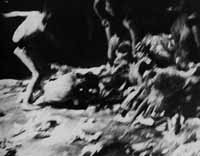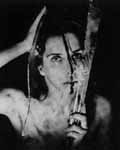Section 1
Ushered in with the 1980s is what appears to be a new trend in feminist thought and practice. Championing the notion of Female "Nature, red in tooth and claw" (to use Tennyson's phrase) as a site constituting power for women, a growing number of artists and critics are embracing the "dark" side of Woman/Nature as an aggressively defiant force that may be channeled against oppression. The idea is that Female Nature's beautiful, enticing, and exploitable appearance is a thin veneer concealing a dark, violent, indomitable force which will lash out if provoked.
To some extent, this movement can be traced back to 1970s French feminisms, radical feminism, and ecofeminism. First, some ecofeminists valorized the essentialist identification of women with nature, asserting the superiority of female nurturance (nature) over masculine dominance and aggression (culture); others sought to revive pre- patriarchal goddesses and ancient rituals in order to resurrect a "female" spirituality. Second, some radical feminists, fighting the essentialist construction of women as passive, nurturing, and "feminine," sought to eliminate the constraints of gender roles and validate women's anger. As Susi Kaplow wrote in 1971, "a woman in our society is denied the forthright expression of her healthy anger," because anger is not "feminine." Women, Kaplow points out, are forced to hold back their anger because "It's unseemly, aesthetically displeasing, and against the sweet, pliant, feminine image to be angry" (Kaplow 37). Third, several of the French Feminists combined Freudian/Lacanian concepts with radical feminism to produce a Natural Woman seething with repressed energies bursting forth in what Cixous describes as "an explosive return, which is absolutely shattering, staggering, overturning, with a force never let loose before. . . " (113).
By the late1980s, the combination of these feminisms produced the "Angry Essentialist" brand of feminism which can be seen in performance works by Karen Finley and Holly Hughes, Andrea Juno and V. Vale's collection of interviews entitled Angry Women, and Camille Paglia's Sexual Personae. All of these works assail the historical/patriarchal equation of Woman with Nature which conceives of both as a passive, nurturing Mother existing only to serve and be exploited by Man, and all promote an archetypal image of "Woman, red in tooth and claw" as a weapon against oppression. Unfortunately, this formulation of Woman is extremely dangerous.
What makes Angry Essentialism both appealing and problematic is its conception of "feminist" liberation, a visionary liberation filtered through 1970s feminisms and, in the cases of Finley and Hughes, presented via complexly theorized feminist performance practices, but ultimately derived from a branch of the male avant-garde rooted deeply in damaging "archetypal" constructs of Woman. Finley and Hughes both painstakingly apply the sort of Brechtian feminist performance techniques Elin Diamond encourages, highlighting the ways in which women and the female body are constructed under patriarchy. But the content of their performances combines feminist and lesbian-feminist concerns with the Dionysian and Shamanic traditions of the male avant-garde.
Since the late 1950s, male performance artists have been appropriating Dionysian and Shamanic ritual practices, shattering taboos and transgressing boundaries in order to liberate humanity, body and soul, and to expand spiritual and material possibilities closed off by the repressive operations of "civilization." In early 1960s Vienna, for example, Hermann Nitsch offered a series of performances called "Orgies Mysteries, Theater," or "OM," in which performers disemboweled bulls or lambs and covered themselves with the blood and entrails (McEvilley 87). Female performances, too, have used similar rituals in their work. For example, in Carolee Schneemann's Meat Joy
(1964), men and women engaged in a sort of orgy amongst carcasses of chickens, fish, and chunks of beef, smearing themselves with blood, and tearing raw meat with their hands. Thomas McEvilley explains that these performances were "essentially revivals of [a] Dionysian ritual," and were "communion rite[s]in which the partaker abandoned his or her individual identity to enter the ego-darkened paths of the unconscious and emerged, having eaten and incorporated the god, redesignated as divine" (87). For similar reasons, performance artists have appropriated the ancient robes of the shaman since at least the 1960s. For example, Schneemann has typically incorporated dream material and trance states into her performances pieces, and in works like Eye-Body
(1963) and Body Collage (1968), she has ritually covered her nude body with symbols from ancient fertility religions. Also, Chris Burden, in Through the Night Softly (1973), "crawled through broken glass with his hands tied behind his back" (McEvilley 92). And Kim Jones, in 1981, "appeared naked except for a mask made of a woman's pantyhose, covered himself with mud, . . . and lay naked on the fire escape to accumulate energy"; he then "smeared himself with [his own shit], embraced members of the audience while covered in it, and finally burned sticks and green plants till the smoke drove the remaining audience from the gallery" (91). Many other performance artists have appropriated shamanic elements into their works, including Gunter Brus, Paul McCarthy, Linda Montano, and Mary Beth Edelson.
The aim of all such performances is to produce catharsis (in the performer, spectator, or both), and in each case the performer transgresses societal taboo and employs bodily abjection to subvert dominant ideologies and achieve transcendence. The appeal of this approach seems to derive from the image of the poete maudit, which is exemplified by nineteenth-century French poet Arthur Rimbaud, a powerful influence on both the twentieth-century avant-gardists and the Angry Essentialists. The problem, however, is that Rimbaud's model, like the Shamanic/Dionysian traditions, is dualistic, based upon binary oppositions of mind/body, society/nature, male/female. The Dionysian/Shamanic performer and the poete maudit corrupts his body in order to release his visionary mind, embraces nature so as to liberate himself from society's artificial constraints, and becomes female-irrational so that he (and his audience) can break free from the masculine-rational. Put another way, the Dionysian/Shamanic performer and poete maudit's program requires that he enter the Other position traditionally allocated to Woman.
| - |

